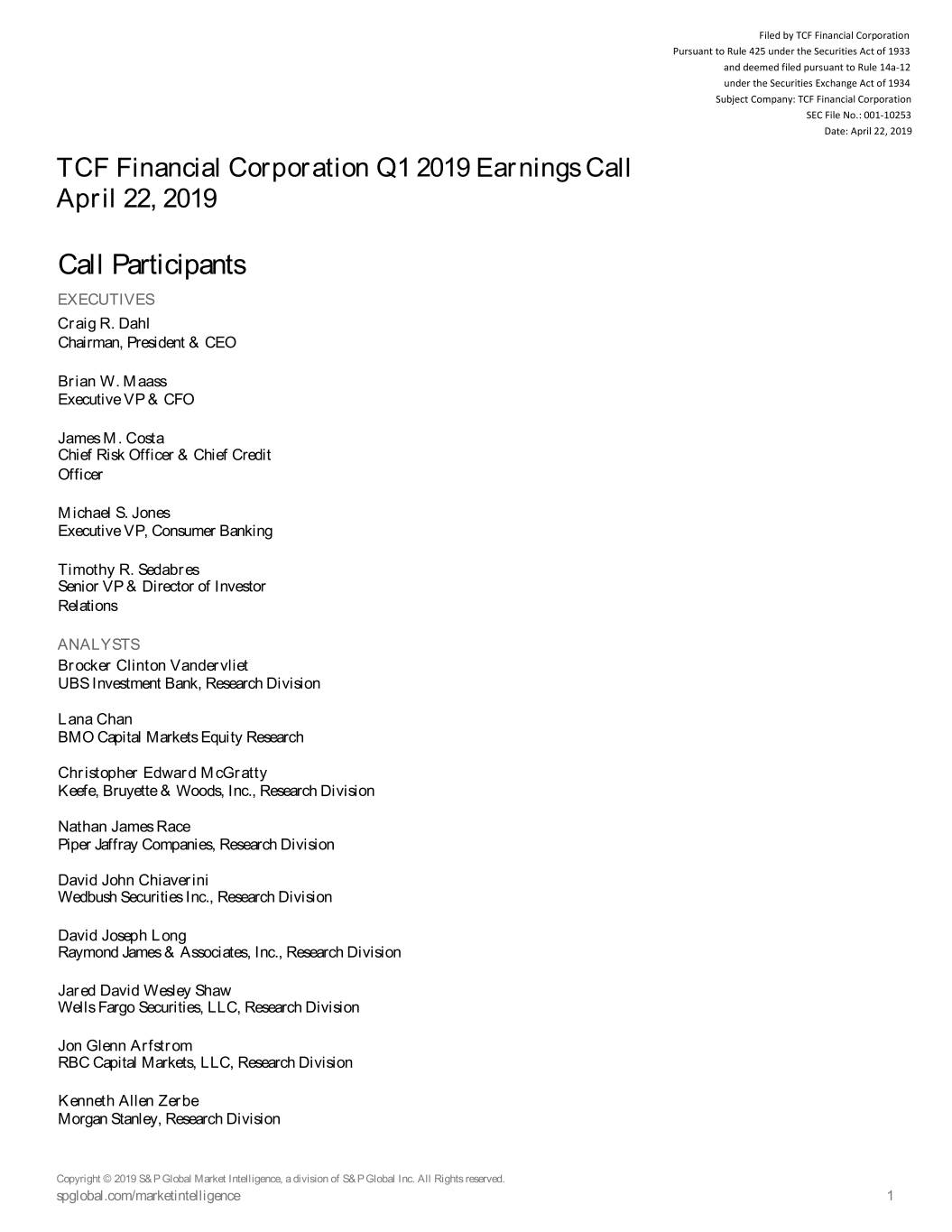
Filed by TCF Financial Corporation Pursuant to Rule 425 under the Securities Act of 1933 and deemed filed pursuant to Rule 14a-12 under the Securities Exchange Act of 1934 Subject Company: TCF Financial Corporation SEC File No.: 001-10253 Date: April 22, 2019 TCF Financial Corporation Q1 2019 Earnings Call April 22, 2019 Call Participants EXECUTIVES Craig R. Dahl Chairman, President & CEO Brian W. Maass Executive VP & CFO James M. Costa Chief Risk Officer & Chief Credit Officer Michael S. Jones Executive VP, Consumer Banking Timothy R. Sedabres Senior VP & Director of Investor Relations ANALYSTS Brocker Clinton Vandervliet UBS Investment Bank, Research Division Lana Chan BMO Capital Markets Equity Research Christopher Edward McGratty Keefe, Bruyette & Woods, Inc., Research Division Nathan James Race Piper Jaffray Companies, Research Division David John Chiaverini Wedbush Securities Inc., Research Division David Joseph Long Raymond James & Associates, Inc., Research Division Jared David Wesley Shaw Wells Fargo Securities, LLC, Research Division Jon Glenn Arfstrom RBC Capital Markets, LLC, Research Division Kenneth Allen Zerbe Morgan Stanley, Research Division Copyright © 2019 S&P Global Market Intelligence, a division of S&P Global Inc. All Rights reserved. spglobal.com/marketintelligence 1
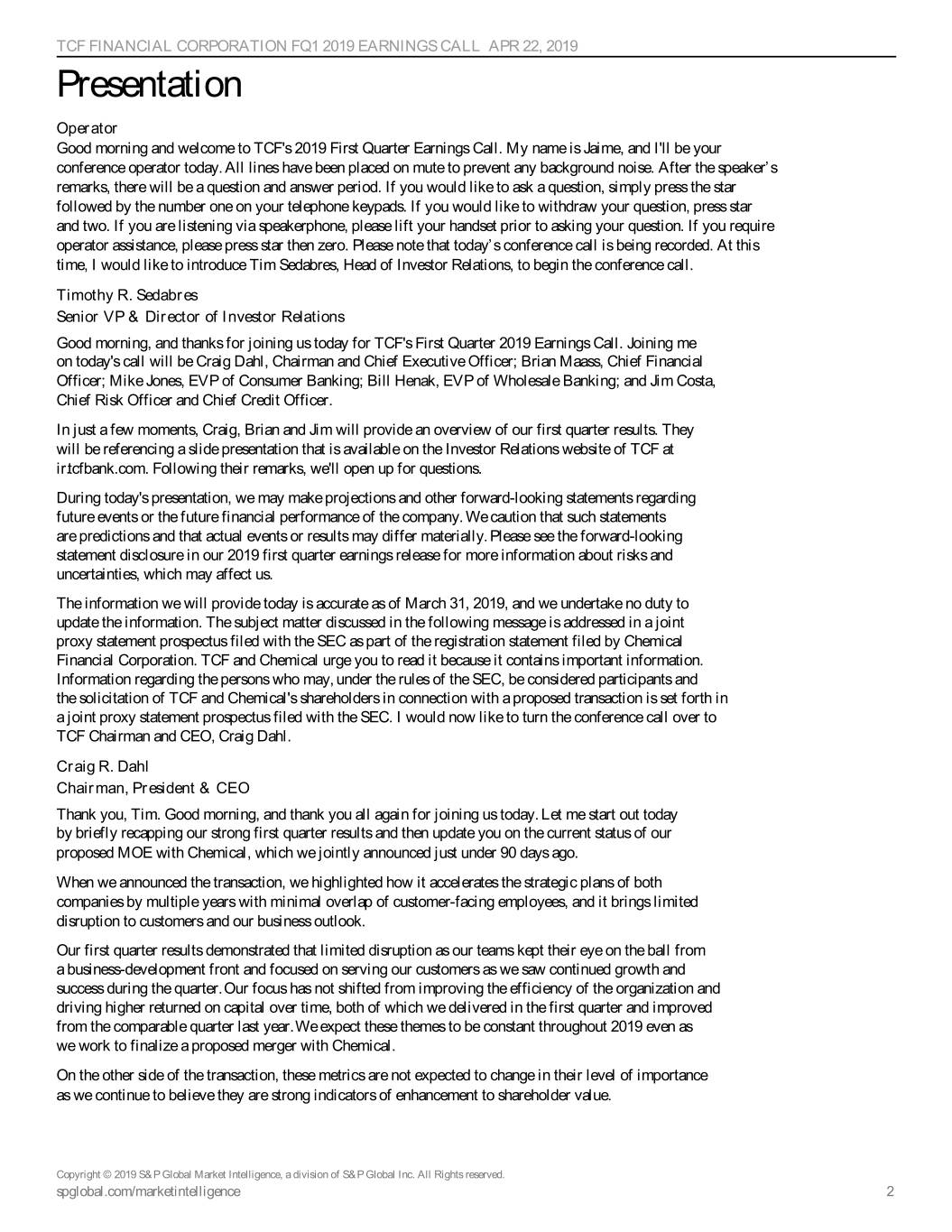
TCF FINANCIAL CORPORATION FQ1 2019 EARNINGS CALL APR 22, 2019 Presentation Operator Good morning and welcome to TCF's 2019 First Quarter Earnings Call. My name is Jaime, and I'll be your conference operator today. All lines have been placed on mute to prevent any background noise. After the speaker’s remarks, there will be a question and answer period. If you would like to ask a question, simply press the star followed by the number one on your telephone keypads. If you would like to withdraw your question, press star and two. If you are listening via speakerphone, please lift your handset prior to asking your question. If you require operator assistance, please press star then zero. Please note that today’s conference call is being recorded. At this time, I would like to introduce Tim Sedabres, Head of Investor Relations, to begin the conference call. Timothy R. Sedabres Senior VP & Director of Investor Relations Good morning, and thanks for joining us today for TCF's First Quarter 2019 Earnings Call. Joining me on today's call will be Craig Dahl, Chairman and Chief Executive Officer; Brian Maass, Chief Financial Officer; Mike Jones, EVP of Consumer Banking; Bill Henak, EVP of Wholesale Banking; and Jim Costa, Chief Risk Officer and Chief Credit Officer. In just a few moments, Craig, Brian and Jim will provide an overview of our first quarter results. They will be referencing a slide presentation that is available on the Investor Relations website of TCF at ir.tcfbank.com. Following their remarks, we'll open up for questions. During today's presentation, we may make projections and other forward-looking statements regarding future events or the future financial performance of the company. We caution that such statements are predictions and that actual events or results may differ materially. Please see the forward-looking statement disclosure in our 2019 first quarter earnings release for more information about risks and uncertainties, which may affect us. The information we will provide today is accurate as of March 31, 2019, and we undertake no duty to update the information. The subject matter discussed in the following message is addressed in a joint proxy statement prospectus filed with the SEC as part of the registration statement filed by Chemical Financial Corporation. TCF and Chemical urge you to read it because it contains important information. Information regarding the persons who may, under the rules of the SEC, be considered participants and the solicitation of TCF and Chemical's shareholders in connection with a proposed transaction is set forth in a joint proxy statement prospectus filed with the SEC. I would now like to turn the conference call over to TCF Chairman and CEO, Craig Dahl. Craig R. Dahl Chairman, President & CEO Thank you, Tim. Good morning, and thank you all again for joining us today. Let me start out today by briefly recapping our strong first quarter results and then update you on the current status of our proposed MOE with Chemical, which we jointly announced just under 90 days ago. When we announced the transaction, we highlighted how it accelerates the strategic plans of both companies by multiple years with minimal overlap of customer-facing employees, and it brings limited disruption to customers and our business outlook. Our first quarter results demonstrated that limited disruption as our teams kept their eye on the ball from a business-development front and focused on serving our customers as we saw continued growth and success during the quarter. Our focus has not shifted from improving the efficiency of the organization and driving higher returned on capital over time, both of which we delivered in the first quarter and improved from the comparable quarter last year. We expect these themes to be constant throughout 2019 even as we work to finalize a proposed merger with Chemical. On the other side of the transaction, these metrics are not expected to change in their level of importance as we continue to believe they are strong indicators of enhancement to shareholder value. Copyright © 2019 S&P Global Market Intelligence, a division of S&P Global Inc. All Rights reserved. spglobal.com/marketintelligence 2
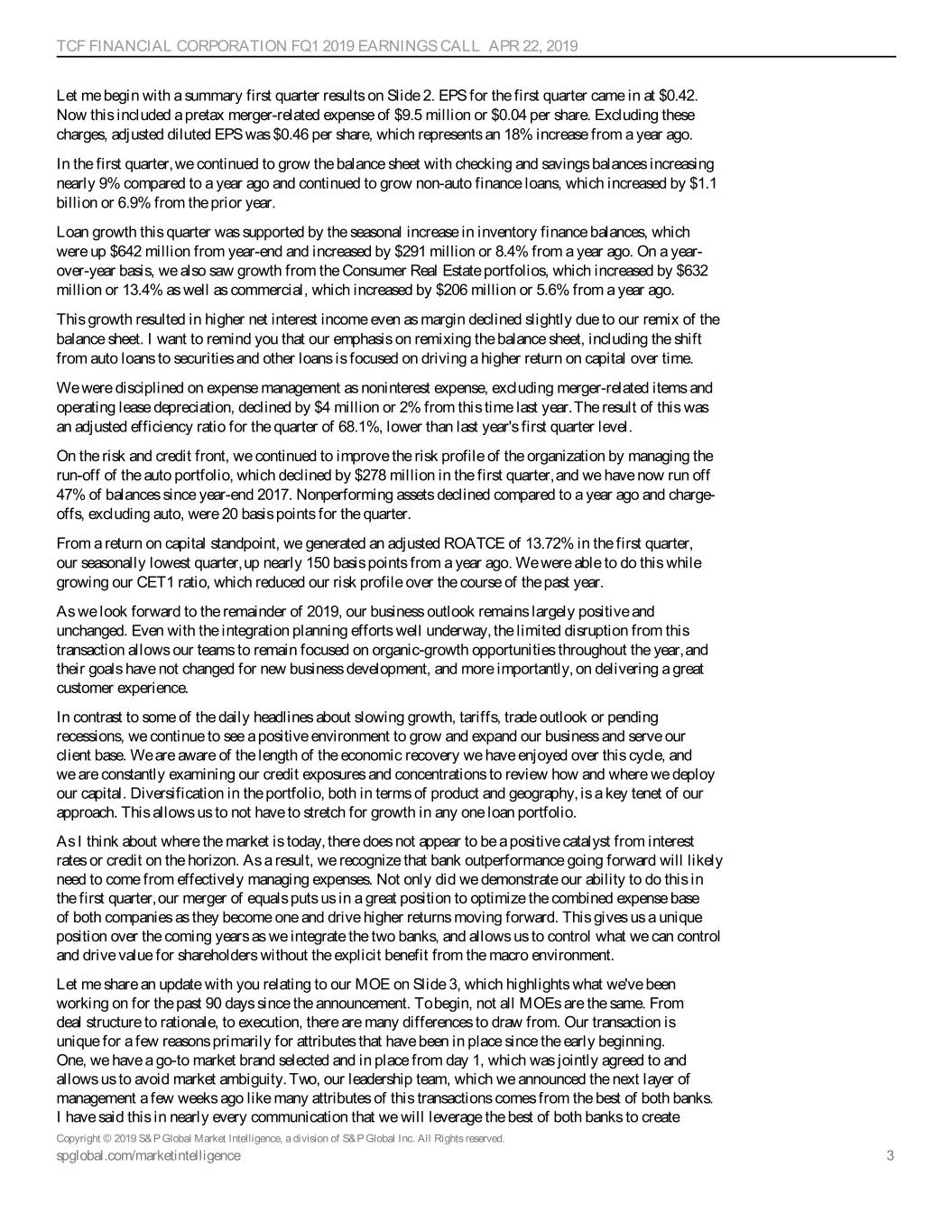
TCF FINANCIAL CORPORATION FQ1 2019 EARNINGS CALL APR 22, 2019 Let me begin with a summary first quarter results on Slide 2. EPS for the first quarter came in at $0.42. Now this included a pretax merger-related expense of $9.5 million or $0.04 per share. Excluding these charges, adjusted diluted EPS was $0.46 per share, which represents an 18% increase from a year ago. In the first quarter, we continued to grow the balance sheet with checking and savings balances increasing nearly 9% compared to a year ago and continued to grow non-auto finance loans, which increased by $1.1 billion or 6.9% from the prior year. Loan growth this quarter was supported by the seasonal increase in inventory finance balances, which were up $642 million from year-end and increased by $291 million or 8.4% from a year ago. On a year- over-year basis, we also saw growth from the Consumer Real Estate portfolios, which increased by $632 million or 13.4% as well as commercial, which increased by $206 million or 5.6% from a year ago. This growth resulted in higher net interest income even as margin declined slightly due to our remix of the balance sheet. I want to remind you that our emphasis on remixing the balance sheet, including the shift from auto loans to securities and other loans is focused on driving a higher return on capital over time. We were disciplined on expense management as noninterest expense, excluding merger-related items and operating lease depreciation, declined by $4 million or 2% from this time last year. The result of this was an adjusted efficiency ratio for the quarter of 68.1%, lower than last year's first quarter level. On the risk and credit front, we continued to improve the risk profile of the organization by managing the run-off of the auto portfolio, which declined by $278 million in the first quarter, and we have now run off 47% of balances since year-end 2017. Nonperforming assets declined compared to a year ago and charge- offs, excluding auto, were 20 basis points for the quarter. From a return on capital standpoint, we generated an adjusted ROATCE of 13.72% in the first quarter, our seasonally lowest quarter, up nearly 150 basis points from a year ago. We were able to do this while growing our CET1 ratio, which reduced our risk profile over the course of the past year. As we look forward to the remainder of 2019, our business outlook remains largely positive and unchanged. Even with the integration planning efforts well underway, the limited disruption from this transaction allows our teams to remain focused on organic-growth opportunities throughout the year, and their goals have not changed for new business development, and more importantly, on delivering a great customer experience. In contrast to some of the daily headlines about slowing growth, tariffs, trade outlook or pending recessions, we continue to see a positive environment to grow and expand our business and serve our client base. We are aware of the length of the economic recovery we have enjoyed over this cycle, and we are constantly examining our credit exposures and concentrations to review how and where we deploy our capital. Diversification in the portfolio, both in terms of product and geography, is a key tenet of our approach. This allows us to not have to stretch for growth in any one loan portfolio. As I think about where the market is today, there does not appear to be a positive catalyst from interest rates or credit on the horizon. As a result, we recognize that bank outperformance going forward will likely need to come from effectively managing expenses. Not only did we demonstrate our ability to do this in the first quarter, our merger of equals puts us in a great position to optimize the combined expense base of both companies as they become one and drive higher returns moving forward. This gives us a unique position over the coming years as we integrate the two banks, and allows us to control what we can control and drive value for shareholders without the explicit benefit from the macro environment. Let me share an update with you relating to our MOE on Slide 3, which highlights what we've been working on for the past 90 days since the announcement. To begin, not all MOEs are the same. From deal structure to rationale, to execution, there are many differences to draw from. Our transaction is unique for a few reasons primarily for attributes that have been in place since the early beginning. One, we have a go-to market brand selected and in place from day 1, which was jointly agreed to and allows us to avoid market ambiguity. Two, our leadership team, which we announced the next layer of management a few weeks ago like many attributes of this transactions comes from the best of both banks. I have said this in nearly every communication that we will leverage the best of both banks to create Copyright © 2019 S&P Global Market Intelligence, a division of S&P Global Inc. All Rights reserved. spglobal.com/marketintelligence 3

TCF FINANCIAL CORPORATION FQ1 2019 EARNINGS CALL APR 22, 2019 the new company and the management team is no exception. Three, Detroit will serve as the combined companies' headquarters. We jointly agreed to this early on in the process, and I strongly believe we are well positioned to capitalize being the largest bank headquartered in Michigan, and we will also maintain substantial operations and presence in Minneapolis, Chicago and Midland. Four, our regulators will be the Federal Reserve at the holding company and the OCC at the bank, and we look forward to continuing our strong working relationship with both regulators. Five, minimal branch and client overlap. This one is key. Most of our cost savings are not coming from closing branches and exiting duplicative commercial teams or loan portfolios. One of the really unique benefits of this deal is that we operate in largely adjacent markets with slightly different business models and product sets. That allows us to be true complementary to each other. Chemical brings traditional commercial banking with C&I and CRE across their many markets, including Detroit, Grand Rapids, Cleveland, Midland and Greater Michigan. TCF brings expertise in lending verticals, such as equipment finance, leasing and inventory finance. When we look at the shared loan relationships between the two banks, it is negligible. We are not in the same commercial relationships, inventory finance programs or leasing transactions. We each bring unique products, relationship managers, clients and programs to each other, which we believe we can leverage and build on to accelerate the growth profile of the combined firm. In the first 90 days, we accomplished a great deal related to integration work. However, we also spent a good deal of time on the road meeting with combined investors in both firms. In these meetings, the top question that came across was, why now? Why do this deal now? As I mentioned previously, this transaction accelerates the strategic plans of both banks by 2 years. Individually, we each had momentum in our standalone business prospects, and very rarely do transactions benefit from two banks with momentum as often one is clearly on stronger footing compared to the other. I truly believe the opportunity to combine these two institutions creates substantial opportunity, whether it is optimized in the expense base to create efficiencies, increasing the already high revenue generation of the combined firm, even more so as we deploy new products to new markets across the Midwest or by leveraging technology spend across a broader customer and asset base. When you think of our investments into digital banking over the past few years, we would not have spent any more dollars on development if we had launched the product and services over a customer base that was 30% to 40% larger. Now onto highlights from the first 90 days of integration planning post announcement. One of our most important accomplishments during the quarter was establishing the joint Integration Management Officer, or IMO. The IMO is made up of approximately 40 work-stream leaders from both organizations to oversee the integration process. These leaders have transitioned to the integration project, are engaged each and every week in planning efforts both in Detroit and Minneapolis. This team is supported by an experienced external advisor we've brought on board to assist with the framework and to support our teams through the process. As we move through this process, we will leverage the experience that Chemical brings from a full-bank M&A standpoint along with our own experience from adding numerous platforms and portfolios over the years. Combined, I believe we have the right people in place with the right experience necessary to support our integration. With all of these pieces in place, we have begun to identify the work streams, and we are making key decisions that will shape the combined organization moving forward. As we sit here today, we are right on track where we're expected to be from an integration perspective. In addition, the registration statement and all regulatory applications were filed on a timely basis. The special meetings of stockholders are expected to be held in June 2019 for both TCF and Chemical. We continue to expect the merger to close late in the third quarter or early in the fourth quarter of 2019. Slide 4 provides an illustration of our balance and experienced leadership team, including a Board that will be made up of 8 directors from each organization and a joint executive management team. I'm very excited about this team given the depth of expertise and industry experience. As I have been telling everyone for the past 3 months, our objective in this MOE has been to utilize the best of both companies, and that is what this joint team brings. Overall, I become more optimistic every day about what this MOE can mean for our investors as well as our customers, communities and employees. We have a unique opportunity to build something special Copyright © 2019 S&P Global Market Intelligence, a division of S&P Global Inc. All Rights reserved. spglobal.com/marketintelligence 4
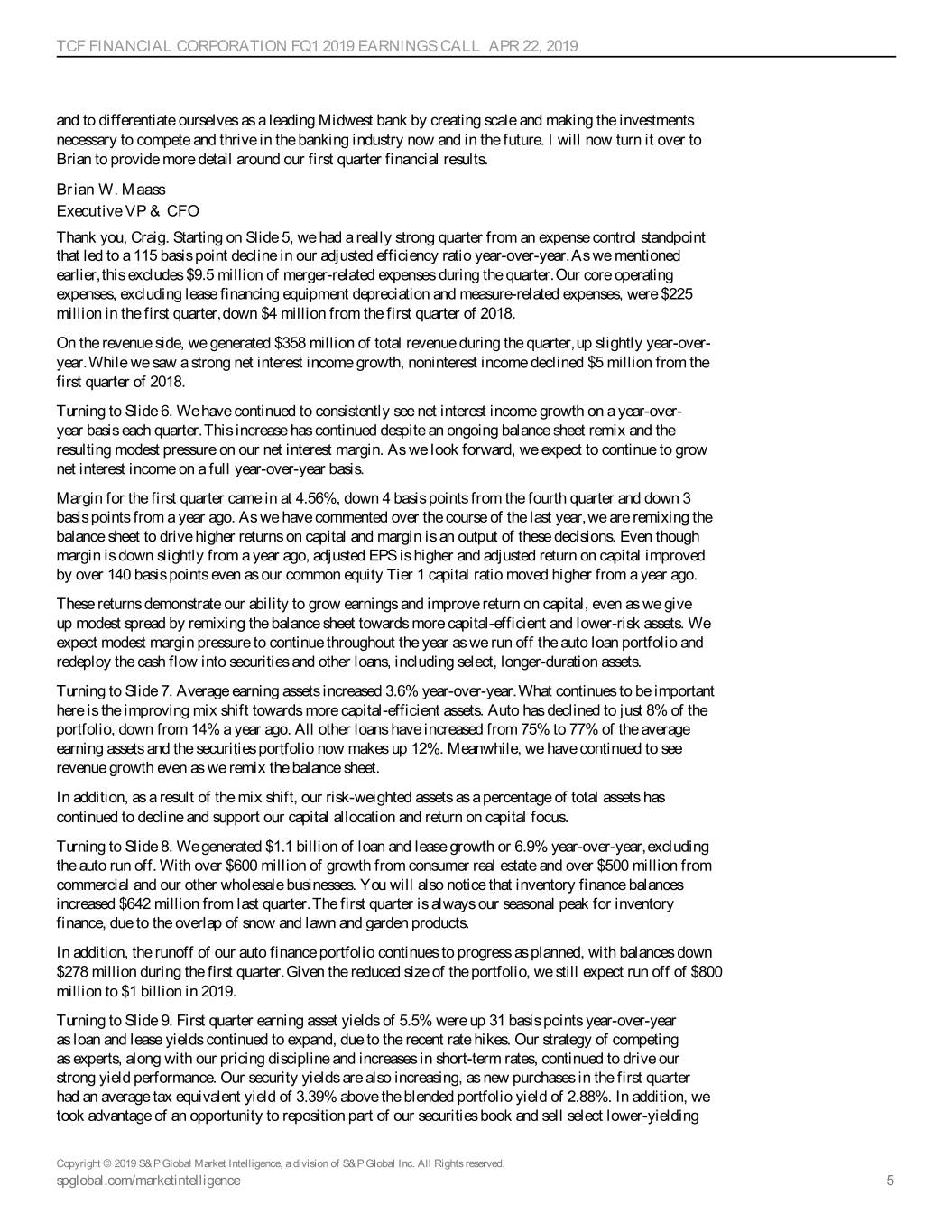
TCF FINANCIAL CORPORATION FQ1 2019 EARNINGS CALL APR 22, 2019 and to differentiate ourselves as a leading Midwest bank by creating scale and making the investments necessary to compete and thrive in the banking industry now and in the future. I will now turn it over to Brian to provide more detail around our first quarter financial results. Brian W. Maass Executive VP & CFO Thank you, Craig. Starting on Slide 5, we had a really strong quarter from an expense control standpoint that led to a 115 basis point decline in our adjusted efficiency ratio year-over-year. As we mentioned earlier, this excludes $9.5 million of merger-related expenses during the quarter. Our core operating expenses, excluding lease financing equipment depreciation and measure-related expenses, were $225 million in the first quarter, down $4 million from the first quarter of 2018. On the revenue side, we generated $358 million of total revenue during the quarter, up slightly year-over- year. While we saw a strong net interest income growth, noninterest income declined $5 million from the first quarter of 2018. Turning to Slide 6. We have continued to consistently see net interest income growth on a year-over- year basis each quarter. This increase has continued despite an ongoing balance sheet remix and the resulting modest pressure on our net interest margin. As we look forward, we expect to continue to grow net interest income on a full year-over-year basis. Margin for the first quarter came in at 4.56%, down 4 basis points from the fourth quarter and down 3 basis points from a year ago. As we have commented over the course of the last year, we are remixing the balance sheet to drive higher returns on capital and margin is an output of these decisions. Even though margin is down slightly from a year ago, adjusted EPS is higher and adjusted return on capital improved by over 140 basis points even as our common equity Tier 1 capital ratio moved higher from a year ago. These returns demonstrate our ability to grow earnings and improve return on capital, even as we give up modest spread by remixing the balance sheet towards more capital-efficient and lower-risk assets. We expect modest margin pressure to continue throughout the year as we run off the auto loan portfolio and redeploy the cash flow into securities and other loans, including select, longer-duration assets. Turning to Slide 7. Average earning assets increased 3.6% year-over-year. What continues to be important here is the improving mix shift towards more capital-efficient assets. Auto has declined to just 8% of the portfolio, down from 14% a year ago. All other loans have increased from 75% to 77% of the average earning assets and the securities portfolio now makes up 12%. Meanwhile, we have continued to see revenue growth even as we remix the balance sheet. In addition, as a result of the mix shift, our risk-weighted assets as a percentage of total assets has continued to decline and support our capital allocation and return on capital focus. Turning to Slide 8. We generated $1.1 billion of loan and lease growth or 6.9% year-over-year, excluding the auto run off. With over $600 million of growth from consumer real estate and over $500 million from commercial and our other wholesale businesses. You will also notice that inventory finance balances increased $642 million from last quarter. The first quarter is always our seasonal peak for inventory finance, due to the overlap of snow and lawn and garden products. In addition, the runoff of our auto finance portfolio continues to progress as planned, with balances down $278 million during the first quarter. Given the reduced size of the portfolio, we still expect run off of $800 million to $1 billion in 2019. Turning to Slide 9. First quarter earning asset yields of 5.5% were up 31 basis points year-over-year as loan and lease yields continued to expand, due to the recent rate hikes. Our strategy of competing as experts, along with our pricing discipline and increases in short-term rates, continued to drive our strong yield performance. Our security yields are also increasing, as new purchases in the first quarter had an average tax equivalent yield of 3.39% above the blended portfolio yield of 2.88%. In addition, we took advantage of an opportunity to reposition part of our securities book and sell select lower-yielding Copyright © 2019 S&P Global Market Intelligence, a division of S&P Global Inc. All Rights reserved. spglobal.com/marketintelligence 5
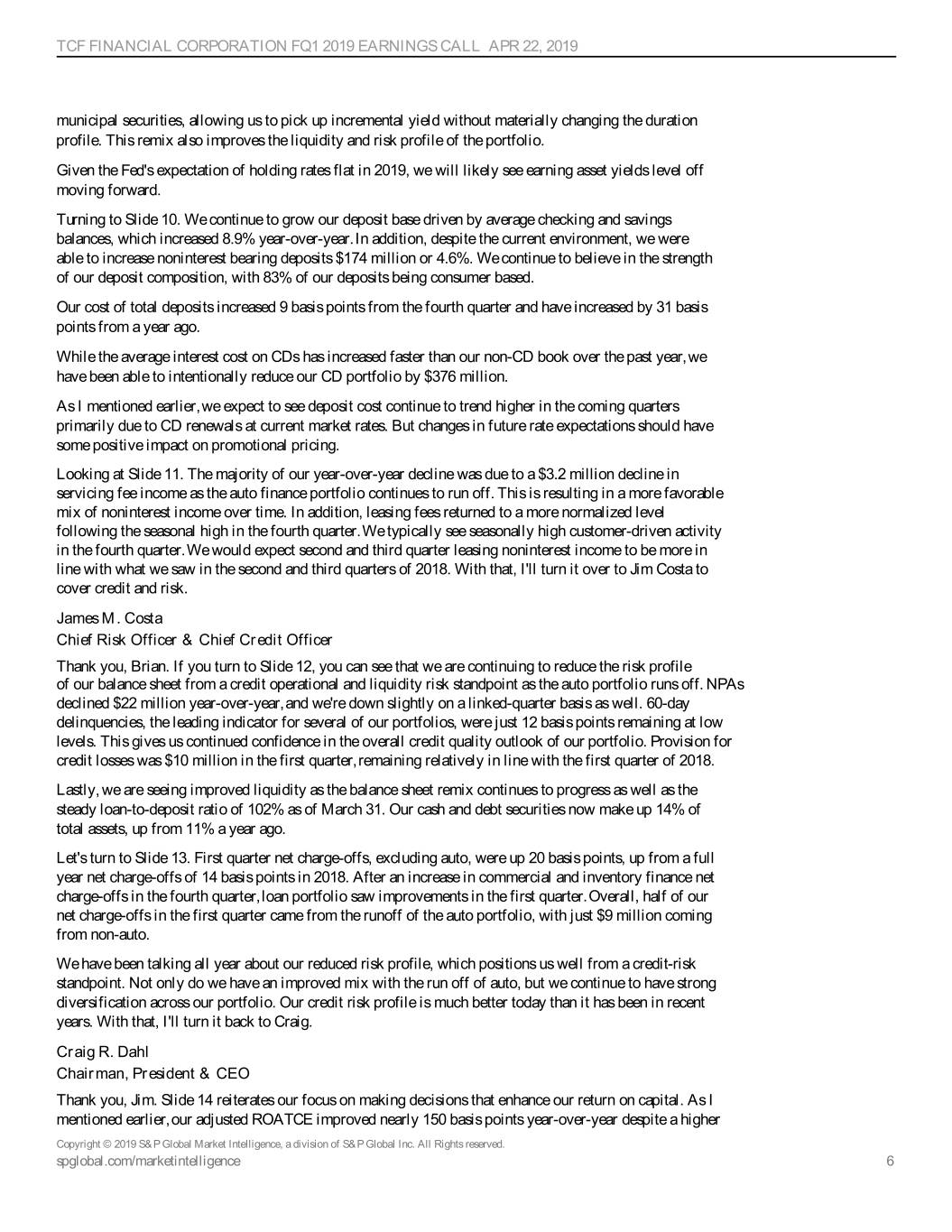
TCF FINANCIAL CORPORATION FQ1 2019 EARNINGS CALL APR 22, 2019 municipal securities, allowing us to pick up incremental yield without materially changing the duration profile. This remix also improves the liquidity and risk profile of the portfolio. Given the Fed's expectation of holding rates flat in 2019, we will likely see earning asset yields level off moving forward. Turning to Slide 10. We continue to grow our deposit base driven by average checking and savings balances, which increased 8.9% year-over-year. In addition, despite the current environment, we were able to increase noninterest bearing deposits $174 million or 4.6%. We continue to believe in the strength of our deposit composition, with 83% of our deposits being consumer based. Our cost of total deposits increased 9 basis points from the fourth quarter and have increased by 31 basis points from a year ago. While the average interest cost on CDs has increased faster than our non-CD book over the past year, we have been able to intentionally reduce our CD portfolio by $376 million. As I mentioned earlier, we expect to see deposit cost continue to trend higher in the coming quarters primarily due to CD renewals at current market rates. But changes in future rate expectations should have some positive impact on promotional pricing. Looking at Slide 11. The majority of our year-over-year decline was due to a $3.2 million decline in servicing fee income as the auto finance portfolio continues to run off. This is resulting in a more favorable mix of noninterest income over time. In addition, leasing fees returned to a more normalized level following the seasonal high in the fourth quarter. We typically see seasonally high customer-driven activity in the fourth quarter. We would expect second and third quarter leasing noninterest income to be more in line with what we saw in the second and third quarters of 2018. With that, I'll turn it over to Jim Costa to cover credit and risk. James M. Costa Chief Risk Officer & Chief Credit Officer Thank you, Brian. If you turn to Slide 12, you can see that we are continuing to reduce the risk profile of our balance sheet from a credit operational and liquidity risk standpoint as the auto portfolio runs off. NPAs declined $22 million year-over-year, and we're down slightly on a linked-quarter basis as well. 60-day delinquencies, the leading indicator for several of our portfolios, were just 12 basis points remaining at low levels. This gives us continued confidence in the overall credit quality outlook of our portfolio. Provision for credit losses was $10 million in the first quarter, remaining relatively in line with the first quarter of 2018. Lastly, we are seeing improved liquidity as the balance sheet remix continues to progress as well as the steady loan-to-deposit ratio of 102% as of March 31. Our cash and debt securities now make up 14% of total assets, up from 11% a year ago. Let's turn to Slide 13. First quarter net charge-offs, excluding auto, were up 20 basis points, up from a full year net charge-offs of 14 basis points in 2018. After an increase in commercial and inventory finance net charge-offs in the fourth quarter, loan portfolio saw improvements in the first quarter. Overall, half of our net charge-offs in the first quarter came from the runoff of the auto portfolio, with just $9 million coming from non-auto. We have been talking all year about our reduced risk profile, which positions us well from a credit-risk standpoint. Not only do we have an improved mix with the run off of auto, but we continue to have strong diversification across our portfolio. Our credit risk profile is much better today than it has been in recent years. With that, I'll turn it back to Craig. Craig R. Dahl Chairman, President & CEO Thank you, Jim. Slide 14 reiterates our focus on making decisions that enhance our return on capital. As I mentioned earlier, our adjusted ROATCE improved nearly 150 basis points year-over-year despite a higher Copyright © 2019 S&P Global Market Intelligence, a division of S&P Global Inc. All Rights reserved. spglobal.com/marketintelligence 6

TCF FINANCIAL CORPORATION FQ1 2019 EARNINGS CALL APR 22, 2019 common equity Tier 1 ratio of 10.79%. We have shown an ability to generate higher return on capital with both higher capital levels and a lower risk profile. As a reminder, we still have $78 million remaining under our current share repurchase authorization. We did not repurchase any shares in the first quarter as the S-4 was not filed until the end of the quarter. We continue to expect to purchase these remaining shares prior to the closing of the merger. So with that, I will open it up for questions. Copyright © 2019 S&P Global Market Intelligence, a division of S&P Global Inc. All Rights reserved. spglobal.com/marketintelligence 7
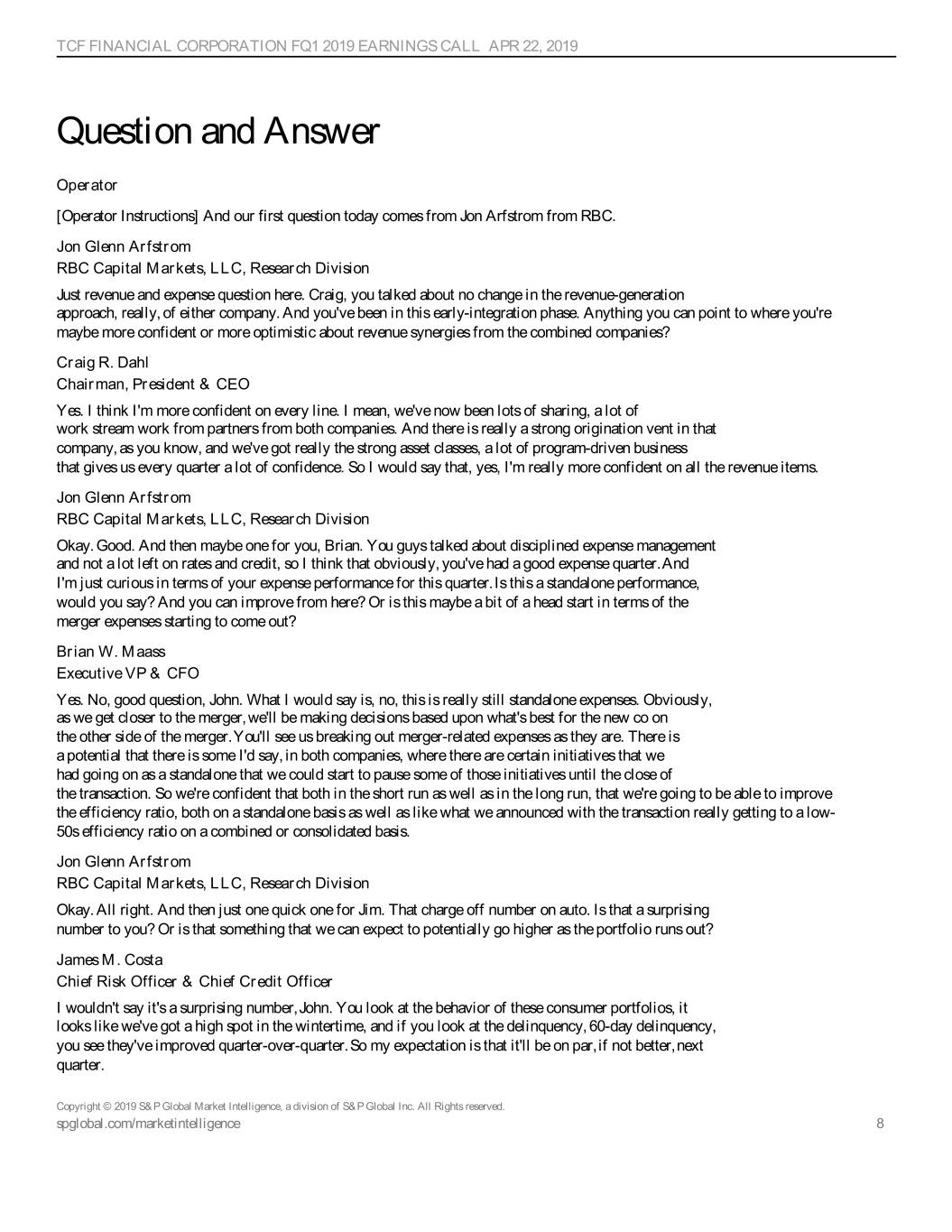
TCF FINANCIAL CORPORATION FQ1 2019 EARNINGS CALL APR 22, 2019 Question and Answer Operator [Operator Instructions] And our first question today comes from Jon Arfstrom from RBC. Jon Glenn Arfstrom RBC Capital Markets, LLC, Research Division Just revenue and expense question here. Craig, you talked about no change in the revenue-generation approach, really, of either company. And you've been in this early-integration phase. Anything you can point to where you're maybe more confident or more optimistic about revenue synergies from the combined companies? Craig R. Dahl Chairman, President & CEO Yes. I think I'm more confident on every line. I mean, we've now been lots of sharing, a lot of work stream work from partners from both companies. And there is really a strong origination vent in that company, as you know, and we've got really the strong asset classes, a lot of program-driven business that gives us every quarter a lot of confidence. So I would say that, yes, I'm really more confident on all the revenue items. Jon Glenn Arfstrom RBC Capital Markets, LLC, Research Division Okay. Good. And then maybe one for you, Brian. You guys talked about disciplined expense management and not a lot left on rates and credit, so I think that obviously, you've had a good expense quarter. And I'm just curious in terms of your expense performance for this quarter. Is this a standalone performance, would you say? And you can improve from here? Or is this maybe a bit of a head start in terms of the merger expenses starting to come out? Brian W. Maass Executive VP & CFO Yes. No, good question, John. What I would say is, no, this is really still standalone expenses. Obviously, as we get closer to the merger, we'll be making decisions based upon what's best for the new co on the other side of the merger. You'll see us breaking out merger-related expenses as they are. There is a potential that there is some I'd say, in both companies, where there are certain initiatives that we had going on as a standalone that we could start to pause some of those initiatives until the close of the transaction. So we're confident that both in the short run as well as in the long run, that we're going to be able to improve the efficiency ratio, both on a standalone basis as well as like what we announced with the transaction really getting to a low- 50s efficiency ratio on a combined or consolidated basis. Jon Glenn Arfstrom RBC Capital Markets, LLC, Research Division Okay. All right. And then just one quick one for Jim. That charge off number on auto. Is that a surprising number to you? Or is that something that we can expect to potentially go higher as the portfolio runs out? James M. Costa Chief Risk Officer & Chief Credit Officer I wouldn't say it's a surprising number, John. You look at the behavior of these consumer portfolios, it looks like we've got a high spot in the wintertime, and if you look at the delinquency, 60-day delinquency, you see they've improved quarter-over-quarter. So my expectation is that it'll be on par, if not better, next quarter. Copyright © 2019 S&P Global Market Intelligence, a division of S&P Global Inc. All Rights reserved. spglobal.com/marketintelligence 8
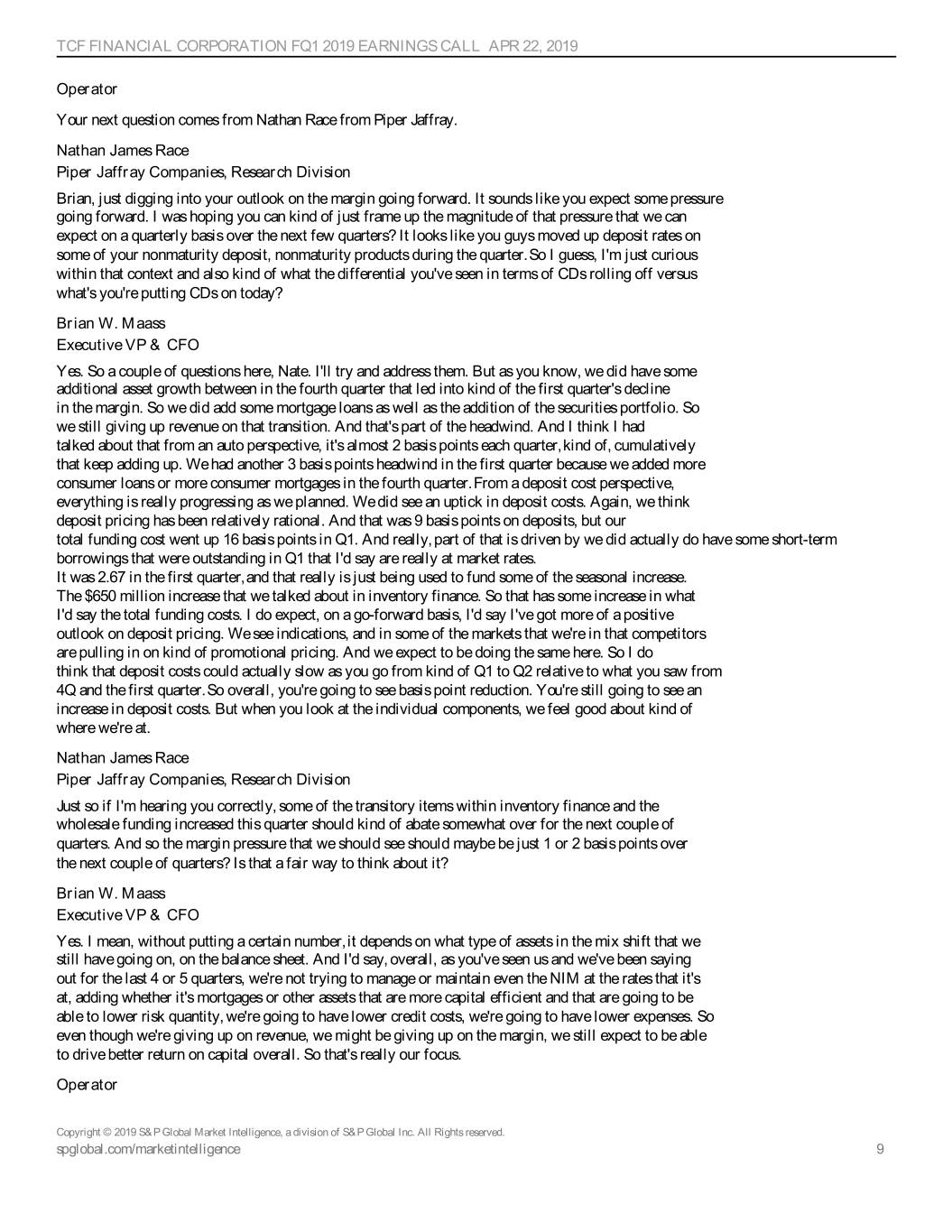
TCF FINANCIAL CORPORATION FQ1 2019 EARNINGS CALL APR 22, 2019 Operator Your next question comes from Nathan Race from Piper Jaffray. Nathan James Race Piper Jaffray Companies, Research Division Brian, just digging into your outlook on the margin going forward. It sounds like you expect some pressure going forward. I was hoping you can kind of just frame up the magnitude of that pressure that we can expect on a quarterly basis over the next few quarters? It looks like you guys moved up deposit rates on some of your nonmaturity deposit, nonmaturity products during the quarter. So I guess, I'm just curious within that context and also kind of what the differential you've seen in terms of CDs rolling off versus what's you're putting CDs on today? Brian W. Maass Executive VP & CFO Yes. So a couple of questions here, Nate. I'll try and address them. But as you know, we did have some additional asset growth between in the fourth quarter that led into kind of the first quarter's decline in the margin. So we did add some mortgage loans as well as the addition of the securities portfolio. So we still giving up revenue on that transition. And that's part of the headwind. And I think I had talked about that from an auto perspective, it's almost 2 basis points each quarter, kind of, cumulatively that keep adding up. We had another 3 basis points headwind in the first quarter because we added more consumer loans or more consumer mortgages in the fourth quarter. From a deposit cost perspective, everything is really progressing as we planned. We did see an uptick in deposit costs. Again, we think deposit pricing has been relatively rational. And that was 9 basis points on deposits, but our total funding cost went up 16 basis points in Q1. And really, part of that is driven by we did actually do have some short-term borrowings that were outstanding in Q1 that I'd say are really at market rates. It was 2.67 in the first quarter, and that really is just being used to fund some of the seasonal increase. The $650 million increase that we talked about in inventory finance. So that has some increase in what I'd say the total funding costs. I do expect, on a go-forward basis, I'd say I've got more of a positive outlook on deposit pricing. We see indications, and in some of the markets that we're in that competitors are pulling in on kind of promotional pricing. And we expect to be doing the same here. So I do think that deposit costs could actually slow as you go from kind of Q1 to Q2 relative to what you saw from 4Q and the first quarter. So overall, you're going to see basis point reduction. You're still going to see an increase in deposit costs. But when you look at the individual components, we feel good about kind of where we're at. Nathan James Race Piper Jaffray Companies, Research Division Just so if I'm hearing you correctly, some of the transitory items within inventory finance and the wholesale funding increased this quarter should kind of abate somewhat over for the next couple of quarters. And so the margin pressure that we should see should maybe be just 1 or 2 basis points over the next couple of quarters? Is that a fair way to think about it? Brian W. Maass Executive VP & CFO Yes. I mean, without putting a certain number, it depends on what type of assets in the mix shift that we still have going on, on the balance sheet. And I'd say, overall, as you've seen us and we've been saying out for the last 4 or 5 quarters, we're not trying to manage or maintain even the NIM at the rates that it's at, adding whether it's mortgages or other assets that are more capital efficient and that are going to be able to lower risk quantity, we're going to have lower credit costs, we're going to have lower expenses. So even though we're giving up on revenue, we might be giving up on the margin, we still expect to be able to drive better return on capital overall. So that's really our focus. Operator Copyright © 2019 S&P Global Market Intelligence, a division of S&P Global Inc. All Rights reserved. spglobal.com/marketintelligence 9
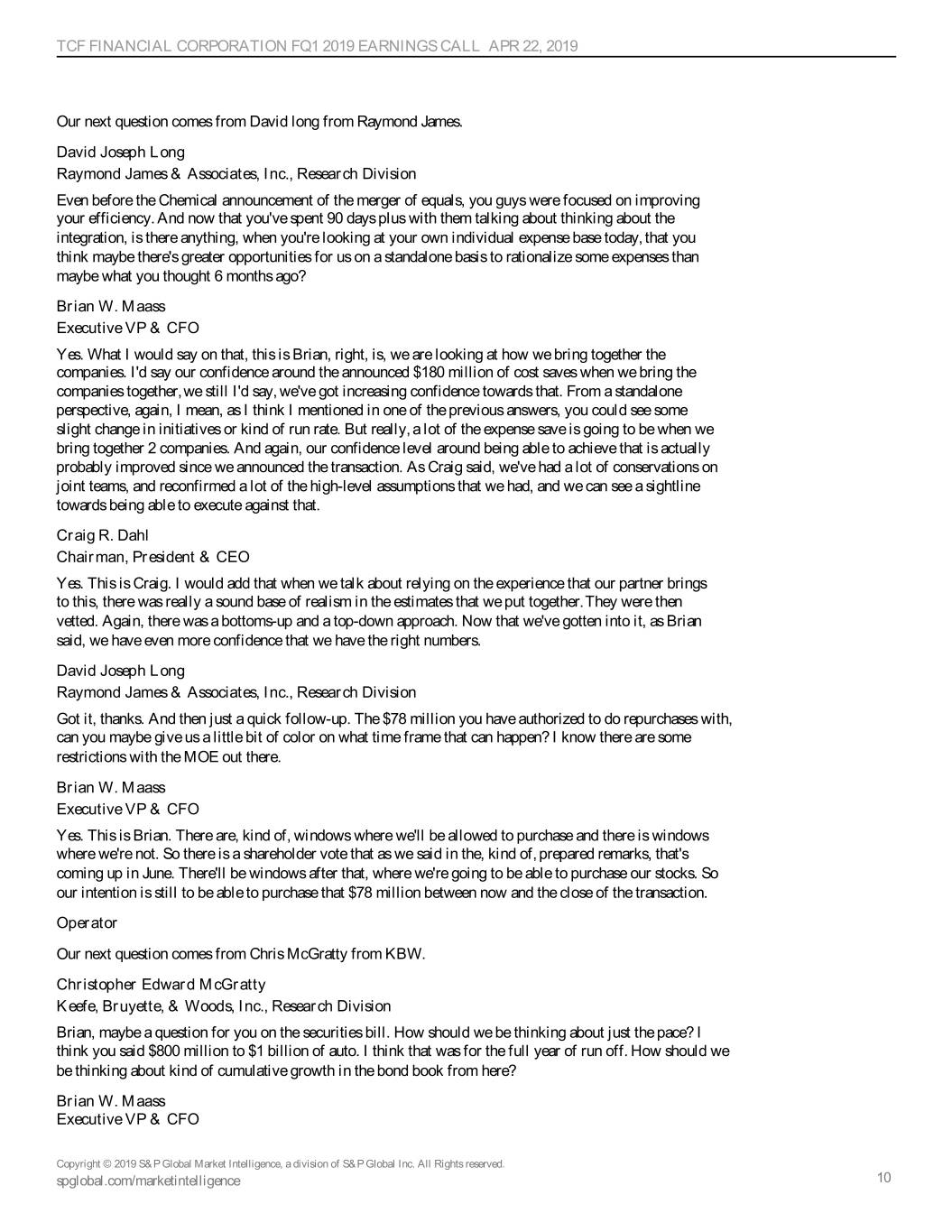
TCF FINANCIAL CORPORATION FQ1 2019 EARNINGS CALL APR 22, 2019 Our next question comes from David long from Raymond James. David Joseph Long Raymond James & Associates, Inc., Research Division Even before the Chemical announcement of the merger of equals, you guys were focused on improving your efficiency. And now that you've spent 90 days plus with them talking about thinking about the integration, is there anything, when you're looking at your own individual expense base today, that you think maybe there's greater opportunities for us on a standalone basis to rationalize some expenses than maybe what you thought 6 months ago? Brian W. Maass Executive VP & CFO Yes. What I would say on that, this is Brian, right, is, we are looking at how we bring together the companies. I'd say our confidence around the announced $180 million of cost saves when we bring the companies together, we still I'd say, we've got increasing confidence towards that. From a standalone perspective, again, I mean, as I think I mentioned in one of the previous answers, you could see some slight change in initiatives or kind of run rate. But really, a lot of the expense save is going to be when we bring together 2 companies. And again, our confidence level around being able to achieve that is actually probably improved since we announced the transaction. As Craig said, we've had a lot of conservations on joint teams, and reconfirmed a lot of the high-level assumptions that we had, and we can see a sightline towards being able to execute against that. Craig R. Dahl Chairman, President & CEO Yes. This is Craig. I would add that when we talk about relying on the experience that our partner brings to this, there was really a sound base of realism in the estimates that we put together. They were then vetted. Again, there was a bottoms-up and a top-down approach. Now that we've gotten into it, as Brian said, we have even more confidence that we have the right numbers. David Joseph Long Raymond James & Associates, Inc., Research Division Got it, thanks. And then just a quick follow-up. The $78 million you have authorized to do repurchases with, can you maybe give us a little bit of color on what time frame that can happen? I know there are some restrictions with the MOE out there. Brian W. Maass Executive VP & CFO Yes. This is Brian. There are, kind of, windows where we'll be allowed to purchase and there is windows where we're not. So there is a shareholder vote that as we said in the, kind of, prepared remarks, that's coming up in June. There'll be windows after that, where we're going to be able to purchase our stocks. So our intention is still to be able to purchase that $78 million between now and the close of the transaction. Operator Our next question comes from Chris McGratty from KBW. Christopher Edward McGratty Keefe, Bruyette, & Woods, Inc., Research Division Brian, maybe a question for you on the securities bill. How should we be thinking about just the pace? I think you said $800 million to $1 billion of auto. I think that was for the full year of run off. How should we be thinking about kind of cumulative growth in the bond book from here? Brian W. Maass Executive VP & CFO Copyright © 2019 S&P Global Market Intelligence, a division of S&P Global Inc. All Rights reserved. spglobal.com/marketintelligence 10
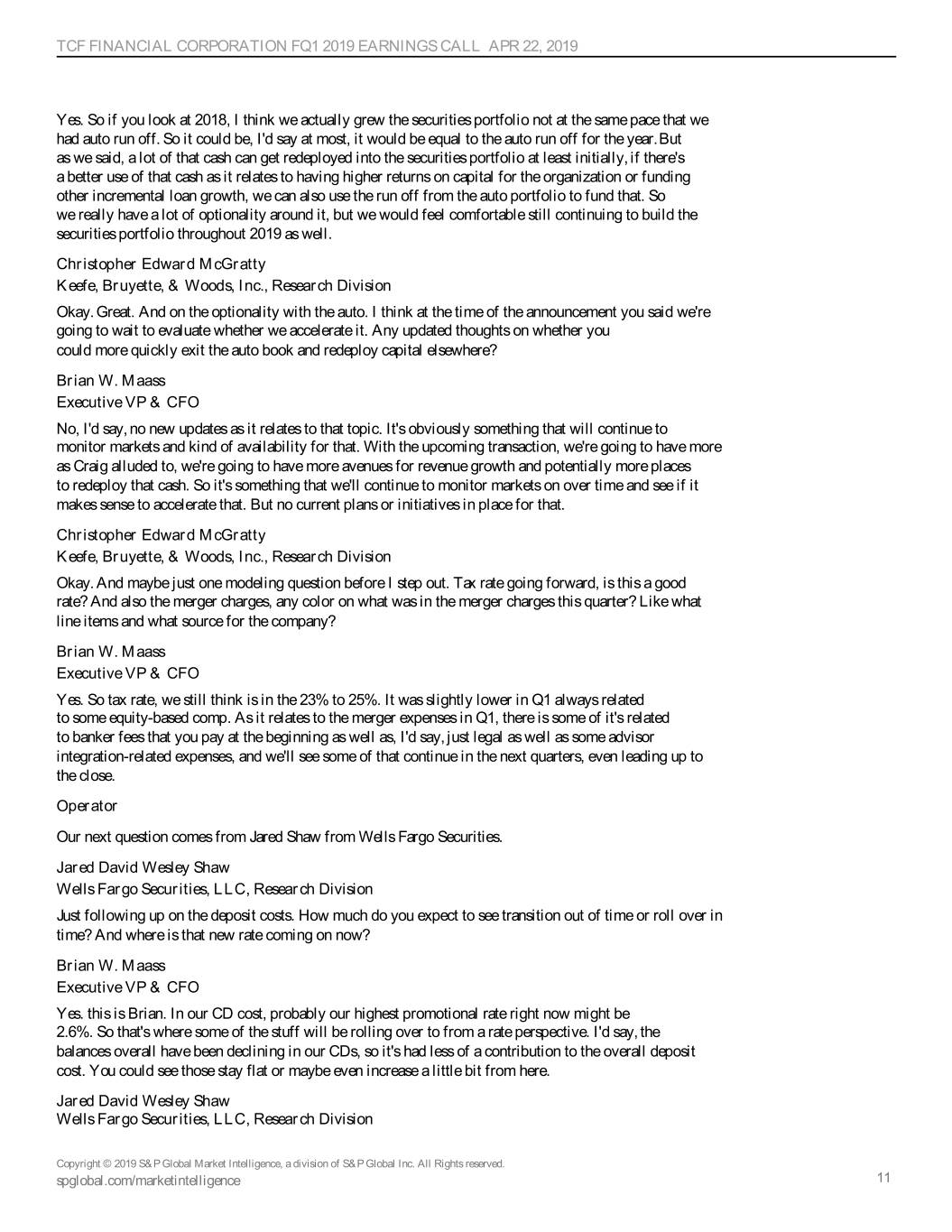
TCF FINANCIAL CORPORATION FQ1 2019 EARNINGS CALL APR 22, 2019 Yes. So if you look at 2018, I think we actually grew the securities portfolio not at the same pace that we had auto run off. So it could be, I'd say at most, it would be equal to the auto run off for the year. But as we said, a lot of that cash can get redeployed into the securities portfolio at least initially, if there's a better use of that cash as it relates to having higher returns on capital for the organization or funding other incremental loan growth, we can also use the run off from the auto portfolio to fund that. So we really have a lot of optionality around it, but we would feel comfortable still continuing to build the securities portfolio throughout 2019 as well. Christopher Edward McGratty Keefe, Bruyette, & Woods, Inc., Research Division Okay. Great. And on the optionality with the auto. I think at the time of the announcement you said we're going to wait to evaluate whether we accelerate it. Any updated thoughts on whether you could more quickly exit the auto book and redeploy capital elsewhere? Brian W. Maass Executive VP & CFO No, I'd say, no new updates as it relates to that topic. It's obviously something that will continue to monitor markets and kind of availability for that. With the upcoming transaction, we're going to have more as Craig alluded to, we're going to have more avenues for revenue growth and potentially more places to redeploy that cash. So it's something that we'll continue to monitor markets on over time and see if it makes sense to accelerate that. But no current plans or initiatives in place for that. Christopher Edward McGratty Keefe, Bruyette, & Woods, Inc., Research Division Okay. And maybe just one modeling question before I step out. Tax rate going forward, is this a good rate? And also the merger charges, any color on what was in the merger charges this quarter? Like what line items and what source for the company? Brian W. Maass Executive VP & CFO Yes. So tax rate, we still think is in the 23% to 25%. It was slightly lower in Q1 always related to some equity-based comp. As it relates to the merger expenses in Q1, there is some of it's related to banker fees that you pay at the beginning as well as, I'd say, just legal as well as some advisor integration-related expenses, and we'll see some of that continue in the next quarters, even leading up to the close. Operator Our next question comes from Jared Shaw from Wells Fargo Securities. Jared David Wesley Shaw Wells Fargo Securities, LLC, Research Division Just following up on the deposit costs. How much do you expect to see transition out of time or roll over in time? And where is that new rate coming on now? Brian W. Maass Executive VP & CFO Yes. this is Brian. In our CD cost, probably our highest promotional rate right now might be 2.6%. So that's where some of the stuff will be rolling over to from a rate perspective. I'd say, the balances overall have been declining in our CDs, so it's had less of a contribution to the overall deposit cost. You could see those stay flat or maybe even increase a little bit from here. Jared David Wesley Shaw Wells Fargo Securities, LLC, Research Division Copyright © 2019 S&P Global Market Intelligence, a division of S&P Global Inc. All Rights reserved. spglobal.com/marketintelligence 11
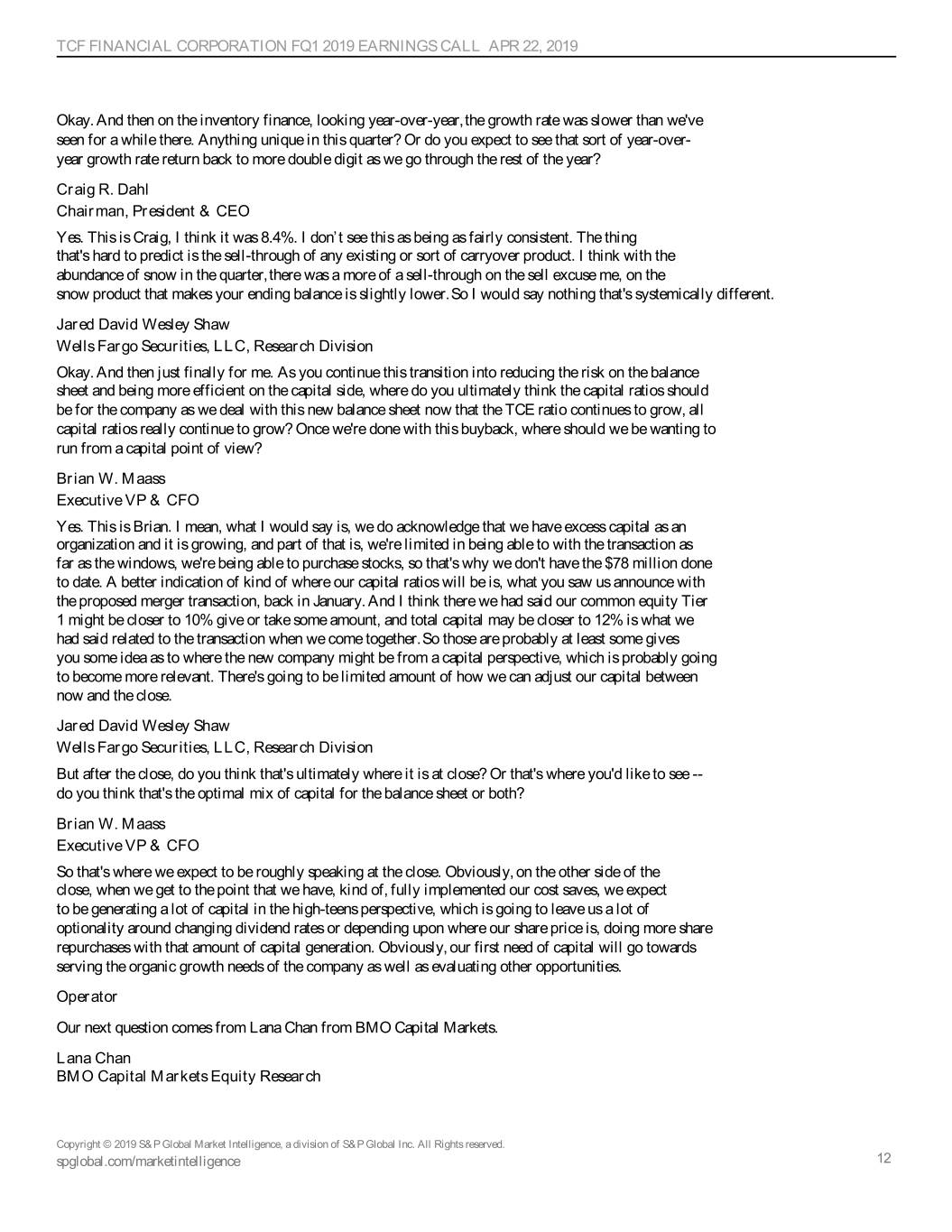
TCF FINANCIAL CORPORATION FQ1 2019 EARNINGS CALL APR 22, 2019 Okay. And then on the inventory finance, looking year-over-year, the growth rate was slower than we've seen for a while there. Anything unique in this quarter? Or do you expect to see that sort of year-over- year growth rate return back to more double digit as we go through the rest of the year? Craig R. Dahl Chairman, President & CEO Yes. This is Craig, I think it was 8.4%. I don’t see this as being as fairly consistent. The thing that's hard to predict is the sell-through of any existing or sort of carryover product. I think with the abundance of snow in the quarter, there was a more of a sell-through on the sell excuse me, on the snow product that makes your ending balance is slightly lower. So I would say nothing that's systemically different. Jared David Wesley Shaw Wells Fargo Securities, LLC, Research Division Okay. And then just finally for me. As you continue this transition into reducing the risk on the balance sheet and being more efficient on the capital side, where do you ultimately think the capital ratios should be for the company as we deal with this new balance sheet now that the TCE ratio continues to grow, all capital ratios really continue to grow? Once we're done with this buyback, where should we be wanting to run from a capital point of view? Brian W. Maass Executive VP & CFO Yes. This is Brian. I mean, what I would say is, we do acknowledge that we have excess capital as an organization and it is growing, and part of that is, we're limited in being able to with the transaction as far as the windows, we're being able to purchase stocks, so that's why we don't have the $78 million done to date. A better indication of kind of where our capital ratios will be is, what you saw us announce with the proposed merger transaction, back in January. And I think there we had said our common equity Tier 1 might be closer to 10% give or take some amount, and total capital may be closer to 12% is what we had said related to the transaction when we come together. So those are probably at least some gives you some idea as to where the new company might be from a capital perspective, which is probably going to become more relevant. There's going to be limited amount of how we can adjust our capital between now and the close. Jared David Wesley Shaw Wells Fargo Securities, LLC, Research Division But after the close, do you think that's ultimately where it is at close? Or that's where you'd like to see -- do you think that's the optimal mix of capital for the balance sheet or both? Brian W. Maass Executive VP & CFO So that's where we expect to be roughly speaking at the close. Obviously, on the other side of the close, when we get to the point that we have, kind of, fully implemented our cost saves, we expect to be generating a lot of capital in the high-teens perspective, which is going to leave us a lot of optionality around changing dividend rates or depending upon where our share price is, doing more share repurchases with that amount of capital generation. Obviously, our first need of capital will go towards serving the organic growth needs of the company as well as evaluating other opportunities. Operator Our next question comes from Lana Chan from BMO Capital Markets. Lana Chan BMO Capital Markets Equity Research Copyright © 2019 S&P Global Market Intelligence, a division of S&P Global Inc. All Rights reserved. spglobal.com/marketintelligence 12

TCF FINANCIAL CORPORATION FQ1 2019 EARNINGS CALL APR 22, 2019 2 questions. One on the core expenses. I think excluding the operating appreciation, it was up about 2% year-over-year. Is that sort of a good run rate going forward of trying to keep a low single-digit growth rate? Brian W. Maass Executive VP & CFO I guess, Lana, what I would say is our this is Brian, on our expenses on a year-over-year basis, excluding the merger-related expenses, it was actually down 2% on a year-over-year basis, not up 2%. Lana Chan BMO Capital Markets Equity Research Well, I was just excluding the operating lease depreciation, too. Brian W. Maass Executive VP & CFO Oh, the operating lease depreciation. Yes. I mean, the operating lease depreciation is really related to transaction activity and to leasing revenues, and that's related to the amount of operating leases that we have on the balance sheet. We continue to see that part of the business continue to grow. So you could see that part grow part. But if that part grows, we will see leasing revenue as somewhat of an offset for that. Lana Chan BMO Capital Markets Equity Research I guess, let me ask it another way, do you expect the overall core expenses fueling the merger charge to be relatively flat to slightly down? Brian W. Maass Executive VP & CFO Yes. I mean, what we're looking at is, we're being able we want to look at still being able to improve the efficiency ratio of the company over the course of 2019. And I think you can see some of the expenses come down as we in the coming quarters. Lana Chan BMO Capital Markets Equity Research Okay. And second question just about the loan loss provision. How should we think about that? Should we think about that to going forward just roughly covering x auto charge-offs? James M. Costa Chief Risk Officer & Chief Credit Officer I think it's been performing in line with our expectations, Lana. This is Jim. And as you can see, the portfolio is running off on auto roughly $300 million thereabouts of $275 million a quarter, and the provision's been coming down accordingly on auto. So what I would say is or the allowance. So I would say consistent with recent experience is what you should expect going forward. There's nothing that's evolved in the portfolio that has surprised us, and therefore, our forward expectations would be consistent with recent history. There is some seasonality, I'd ask you to keep an eye on that. Year-over-year comps are certainly important. But really, no change in the projected outlook. Operator Our next question comes from Ken Zerbe from Morgan Stanley. Kenneth Allen Zerbe Morgan Stanley, Research Division Copyright © 2019 S&P Global Market Intelligence, a division of S&P Global Inc. All Rights reserved. spglobal.com/marketintelligence 13

TCF FINANCIAL CORPORATION FQ1 2019 EARNINGS CALL APR 22, 2019 First question. Just on Slide 11, the servicing fee income has done, I guess, $3 million year-over-year. Should we expect that the entire servicing fee line so if not entirely sure how much is left over, but I assume probably sub-$10 million. But does that whole line go away as the auto loans go away? Or is there some other mismatch there? Brian W. Maass Executive VP & CFO No. This is Brian. So that line will continue to go down as it relates to auto servicing fee income. But we also do have servicing fee income on our consumer real estate portfolio. So it won't go down to zero. Kenneth Allen Zerbe Morgan Stanley, Research Division Got you. Okay. Even though all right. So the $3.2 million is including both the auto and the resi portfolio? Brian W. Maass Executive VP & CFO That's correct. Kenneth Allen Zerbe Morgan Stanley, Research Division They were combined down to that much. All right. That makes sense. Brian W. Maass Executive VP & CFO They were combined into that line, correct. The $3 million decline probably relates to auto from a year- over-year perspective, but what you see remaining on that line would be both auto as well as consumer real estate. Kenneth Allen Zerbe Morgan Stanley, Research Division Got you. Okay. That's fair. And sorry, just going back to the expense piece. I just want to be really clear, I think you had mentioned this to Lana's question that some of the expenses could actually come down, but it didn't sound like you meant all the expenses would come down. So I mean, is it was there anything unusual in terms of or any unusual items that aired on the low side this quarter that may tick up next quarter? Brian W. Maass Executive VP & CFO Yes. I mean there are certain things. Like even you saw there are, as it relates to some of the I think it's occupancy and equipment, that has some of our hardware and software costs and some of the investments that we've made into technology. So some of those lines can continue to go up. But again, I look at in general, you're going to see a lot of the expense control management on between now and into the close of the transaction. Kenneth Allen Zerbe Morgan Stanley, Research Division Got it. Okay, so we should probably focus more on the efficiency ratio rather than the dollar numbers? Brian W. Maass Executive VP & CFO Correct. And it may not as you know, we've got just seasonality in our business overall, right? So we've got $650 million more of assets in Q1. Those assets, some of that will come down as we get in the Copyright © 2019 S&P Global Market Intelligence, a division of S&P Global Inc. All Rights reserved. spglobal.com/marketintelligence 14
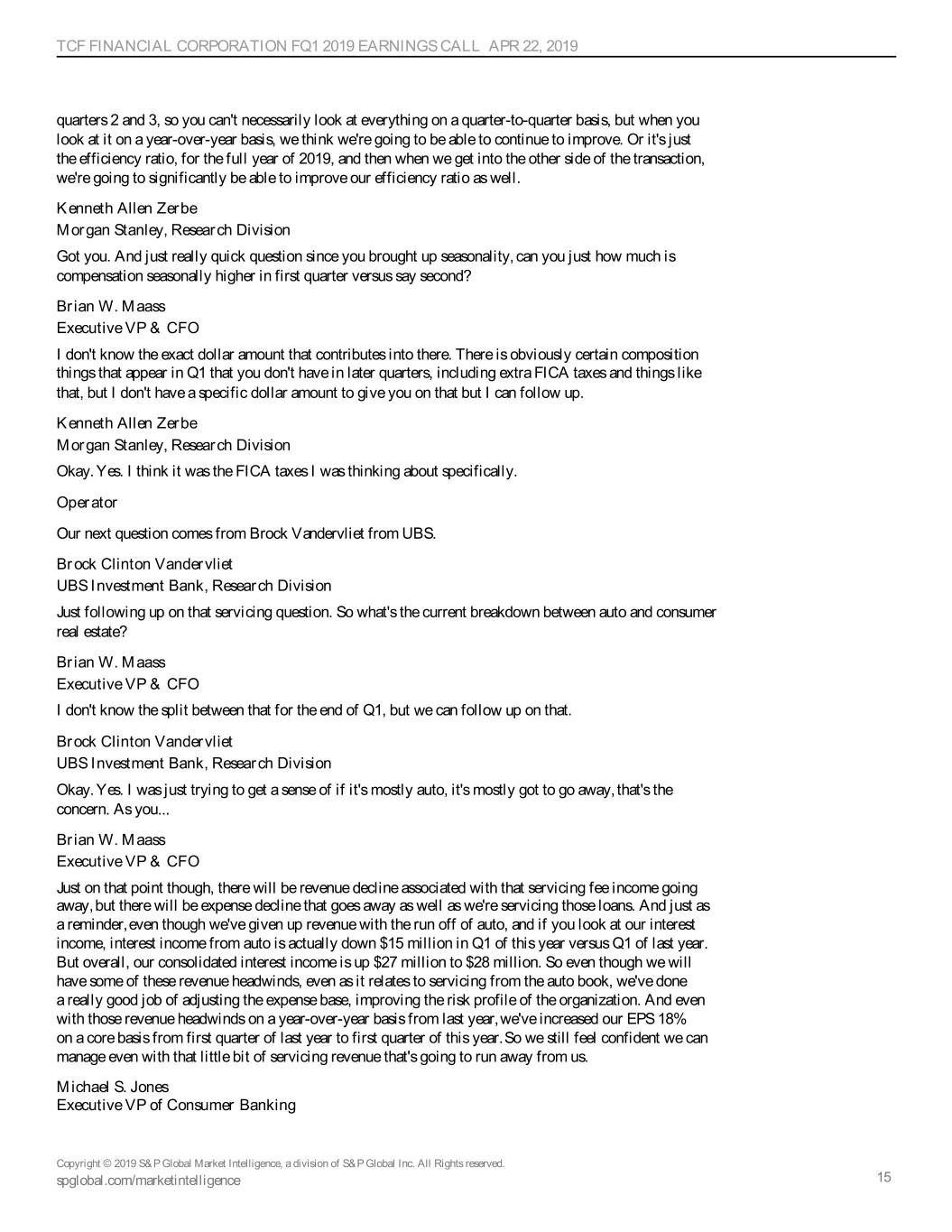
TCF FINANCIAL CORPORATION FQ1 2019 EARNINGS CALL APR 22, 2019 quarters 2 and 3, so you can't necessarily look at everything on a quarter-to-quarter basis, but when you look at it on a year-over-year basis, we think we're going to be able to continue to improve. Or it's just the efficiency ratio, for the full year of 2019, and then when we get into the other side of the transaction, we're going to significantly be able to improve our efficiency ratio as well. Kenneth Allen Zerbe Morgan Stanley, Research Division Got you. And just really quick question since you brought up seasonality, can you just how much is compensation seasonally higher in first quarter versus say second? Brian W. Maass Executive VP & CFO I don't know the exact dollar amount that contributes into there. There is obviously certain composition things that appear in Q1 that you don't have in later quarters, including extra FICA taxes and things like that, but I don't have a specific dollar amount to give you on that but I can follow up. Kenneth Allen Zerbe Morgan Stanley, Research Division Okay. Yes. I think it was the FICA taxes I was thinking about specifically. Operator Our next question comes from Brock Vandervliet from UBS. Brock Clinton Vandervliet UBS Investment Bank, Research Division Just following up on that servicing question. So what's the current breakdown between auto and consumer real estate? Brian W. Maass Executive VP & CFO I don't know the split between that for the end of Q1, but we can follow up on that. Brock Clinton Vandervliet UBS Investment Bank, Research Division Okay. Yes. I was just trying to get a sense of if it's mostly auto, it's mostly got to go away, that's the concern. As you... Brian W. Maass Executive VP & CFO Just on that point though, there will be revenue decline associated with that servicing fee income going away, but there will be expense decline that goes away as well as we're servicing those loans. And just as a reminder, even though we've given up revenue with the run off of auto, and if you look at our interest income, interest income from auto is actually down $15 million in Q1 of this year versus Q1 of last year. But overall, our consolidated interest income is up $27 million to $28 million. So even though we will have some of these revenue headwinds, even as it relates to servicing from the auto book, we've done a really good job of adjusting the expense base, improving the risk profile of the organization. And even with those revenue headwinds on a year-over-year basis from last year, we've increased our EPS 18% on a core basis from first quarter of last year to first quarter of this year. So we still feel confident we can manage even with that little bit of servicing revenue that's going to run away from us. Michael S. Jones Executive VP of Consumer Banking Copyright © 2019 S&P Global Market Intelligence, a division of S&P Global Inc. All Rights reserved. spglobal.com/marketintelligence 15
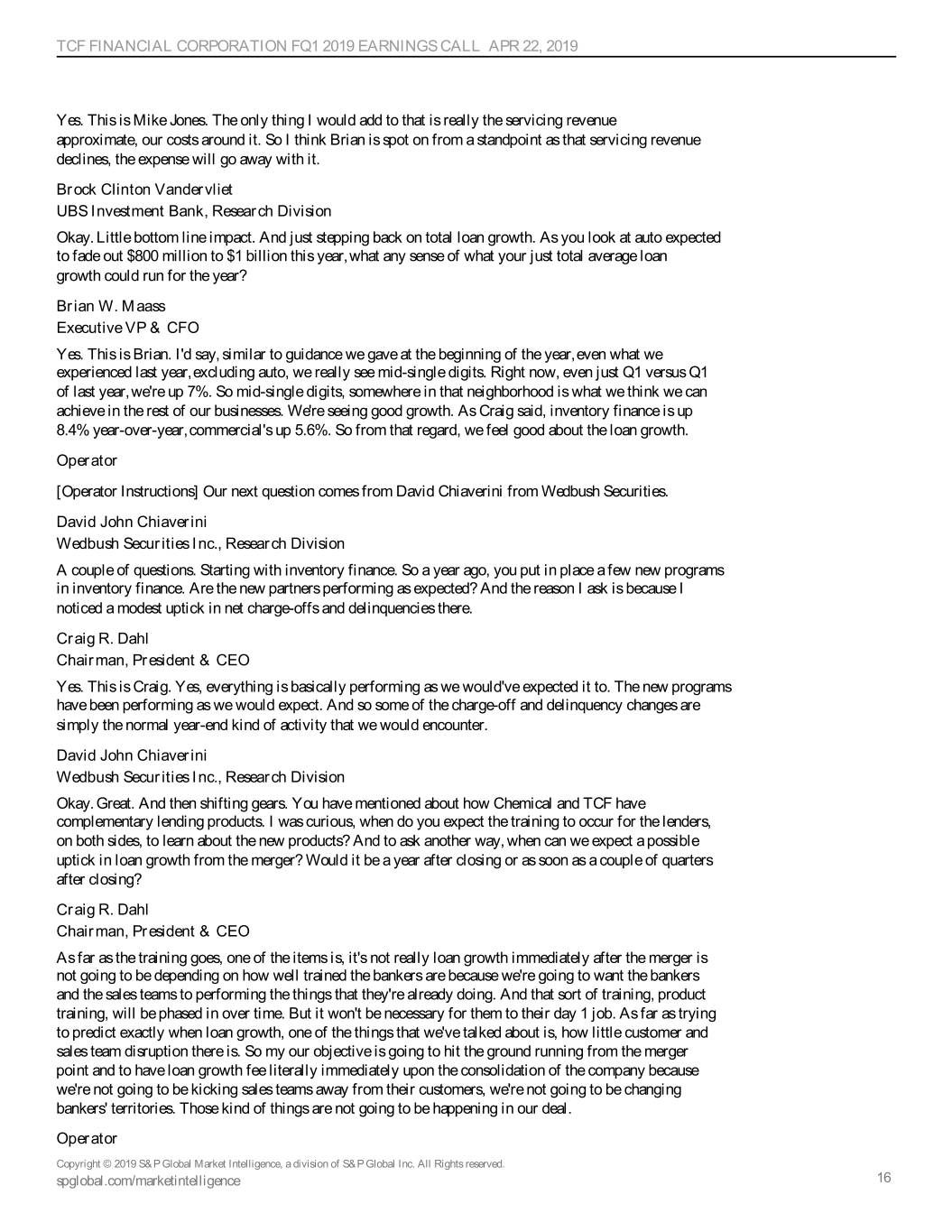
TCF FINANCIAL CORPORATION FQ1 2019 EARNINGS CALL APR 22, 2019 Yes. This is Mike Jones. The only thing I would add to that is really the servicing revenue approximate, our costs around it. So I think Brian is spot on from a standpoint as that servicing revenue declines, the expense will go away with it. Brock Clinton Vandervliet UBS Investment Bank, Research Division Okay. Little bottom line impact. And just stepping back on total loan growth. As you look at auto expected to fade out $800 million to $1 billion this year, what any sense of what your just total average loan growth could run for the year? Brian W. Maass Executive VP & CFO Yes. This is Brian. I'd say, similar to guidance we gave at the beginning of the year, even what we experienced last year, excluding auto, we really see mid-single digits. Right now, even just Q1 versus Q1 of last year, we're up 7%. So mid-single digits, somewhere in that neighborhood is what we think we can achieve in the rest of our businesses. We're seeing good growth. As Craig said, inventory finance is up 8.4% year-over-year, commercial's up 5.6%. So from that regard, we feel good about the loan growth. Operator [Operator Instructions] Our next question comes from David Chiaverini from Wedbush Securities. David John Chiaverini Wedbush Securities Inc., Research Division A couple of questions. Starting with inventory finance. So a year ago, you put in place a few new programs in inventory finance. Are the new partners performing as expected? And the reason I ask is because I noticed a modest uptick in net charge-offs and delinquencies there. Craig R. Dahl Chairman, President & CEO Yes. This is Craig. Yes, everything is basically performing as we would've expected it to. The new programs have been performing as we would expect. And so some of the charge-off and delinquency changes are simply the normal year-end kind of activity that we would encounter. David John Chiaverini Wedbush Securities Inc., Research Division Okay. Great. And then shifting gears. You have mentioned about how Chemical and TCF have complementary lending products. I was curious, when do you expect the training to occur for the lenders, on both sides, to learn about the new products? And to ask another way, when can we expect a possible uptick in loan growth from the merger? Would it be a year after closing or as soon as a couple of quarters after closing? Craig R. Dahl Chairman, President & CEO As far as the training goes, one of the items is, it's not really loan growth immediately after the merger is not going to be depending on how well trained the bankers are because we're going to want the bankers and the sales teams to performing the things that they're already doing. And that sort of training, product training, will be phased in over time. But it won't be necessary for them to their day 1 job. As far as trying to predict exactly when loan growth, one of the things that we've talked about is, how little customer and sales team disruption there is. So my our objective is going to hit the ground running from the merger point and to have loan growth fee literally immediately upon the consolidation of the company because we're not going to be kicking sales teams away from their customers, we're not going to be changing bankers' territories. Those kind of things are not going to be happening in our deal. Operator Copyright © 2019 S&P Global Market Intelligence, a division of S&P Global Inc. All Rights reserved. spglobal.com/marketintelligence 16
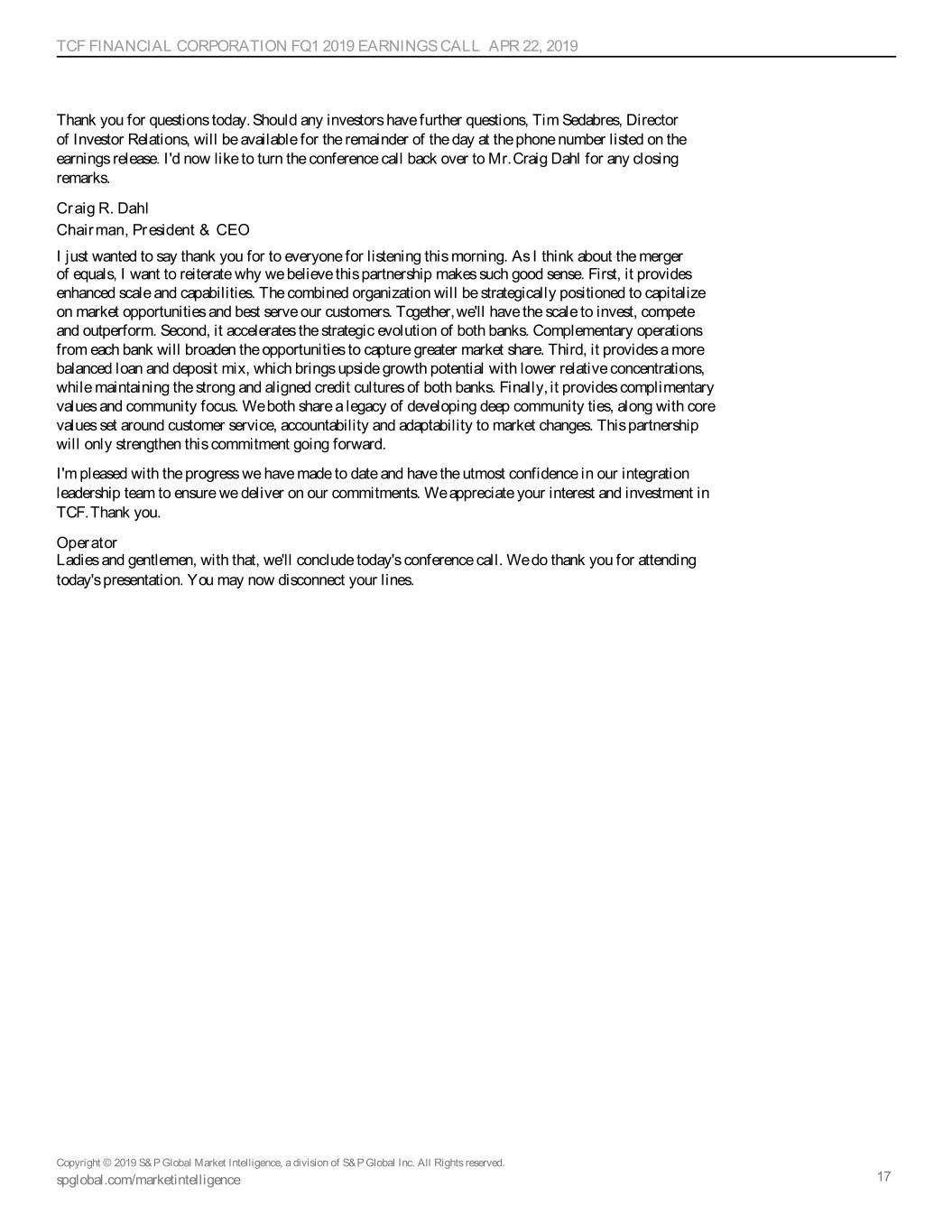
TCF FINANCIAL CORPORATION FQ1 2019 EARNINGS CALL APR 22, 2019 Thank you for questions today. Should any investors have further questions, Tim Sedabres, Director of Investor Relations, will be available for the remainder of the day at the phone number listed on the earnings release. I'd now like to turn the conference call back over to Mr. Craig Dahl for any closing remarks. Craig R. Dahl Chairman, President & CEO I just wanted to say thank you for to everyone for listening this morning. As I think about the merger of equals, I want to reiterate why we believe this partnership makes such good sense. First, it provides enhanced scale and capabilities. The combined organization will be strategically positioned to capitalize on market opportunities and best serve our customers. Together, we'll have the scale to invest, compete and outperform. Second, it accelerates the strategic evolution of both banks. Complementary operations from each bank will broaden the opportunities to capture greater market share. Third, it provides a more balanced loan and deposit mix, which brings upside growth potential with lower relative concentrations, while maintaining the strong and aligned credit cultures of both banks. Finally, it provides complimentary values and community focus. We both share a legacy of developing deep community ties, along with core values set around customer service, accountability and adaptability to market changes. This partnership will only strengthen this commitment going forward. I'm pleased with the progress we have made to date and have the utmost confidence in our integration leadership team to ensure we deliver on our commitments. We appreciate your interest and investment in TCF. Thank you. Operator Ladies and gentlemen, with that, we'll conclude today's conference call. We do thank you for attending today's presentation. You may now disconnect your lines. Copyright © 2019 S&P Global Market Intelligence, a division of S&P Global Inc. All Rights reserved. spglobal.com/marketintelligence 17
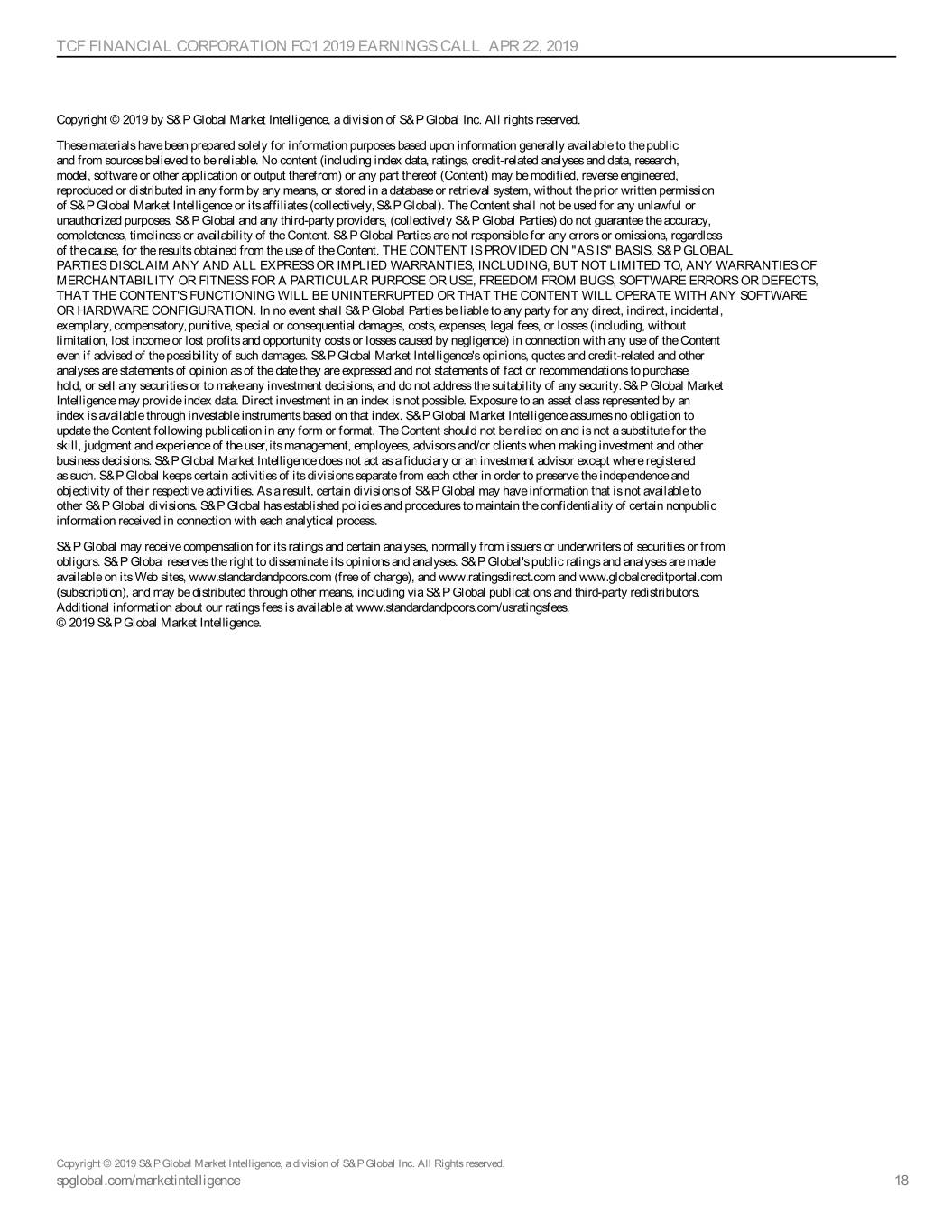
TCF FINANCIAL CORPORATION FQ1 2019 EARNINGS CALL APR 22, 2019 Copyright © 2019 by S&P Global Market Intelligence, a division of S&P Global Inc. All rights reserved. These materials have been prepared solely for information purposes based upon information generally available to the public and from sources believed to be reliable. No content (including index data, ratings, credit-related analyses and data, research, model, software or other application or output therefrom) or any part thereof (Content) may be modified, reverse engineered, reproduced or distributed in any form by any means, or stored in a database or retrieval system, without the prior written permission of S&P Global Market Intelligence or its affiliates (collectively, S&P Global). The Content shall not be used for any unlawful or unauthorized purposes. S&P Global and any third-party providers, (collectively S&P Global Parties) do not guarantee the accuracy, completeness, timeliness or availability of the Content. S&P Global Parties are not responsible for any errors or omissions, regardless of the cause, for the results obtained from the use of the Content. THE CONTENT IS PROVIDED ON "AS IS" BASIS. S&P GLOBAL PARTIES DISCLAIM ANY AND ALL EXPRESS OR IMPLIED WARRANTIES, INCLUDING, BUT NOT LIMITED TO, ANY WARRANTIES OF MERCHANTABILITY OR FITNESS FOR A PARTICULAR PURPOSE OR USE, FREEDOM FROM BUGS, SOFTWARE ERRORS OR DEFECTS, THAT THE CONTENT'S FUNCTIONING WILL BE UNINTERRUPTED OR THAT THE CONTENT WILL OPERATE WITH ANY SOFTWARE OR HARDWARE CONFIGURATION. In no event shall S&P Global Parties be liable to any party for any direct, indirect, incidental, exemplary, compensatory, punitive, special or consequential damages, costs, expenses, legal fees, or losses (including, without limitation, lost income or lost profits and opportunity costs or losses caused by negligence) in connection with any use of the Content even if advised of the possibility of such damages. S&P Global Market Intelligence's opinions, quotes and credit-related and other analyses are statements of opinion as of the date they are expressed and not statements of fact or recommendations to purchase, hold, or sell any securities or to make any investment decisions, and do not address the suitability of any security. S&P Global Market Intelligence may provide index data. Direct investment in an index is not possible. Exposure to an asset class represented by an index is available through investable instruments based on that index. S&P Global Market Intelligence assumes no obligation to update the Content following publication in any form or format. The Content should not be relied on and is not a substitute for the skill, judgment and experience of the user, its management, employees, advisors and/or clients when making investment and other business decisions. S&P Global Market Intelligence does not act as a fiduciary or an investment advisor except where registered as such. S&P Global keeps certain activities of its divisions separate from each other in order to preserve the independence and objectivity of their respective activities. As a result, certain divisions of S&P Global may have information that is not available to other S&P Global divisions. S&P Global has established policies and procedures to maintain the confidentiality of certain nonpublic information received in connection with each analytical process. S&P Global may receive compensation for its ratings and certain analyses, normally from issuers or underwriters of securities or from obligors. S&P Global reserves the right to disseminate its opinions and analyses. S&P Global's public ratings and analyses are made available on its Web sites, www.standardandpoors.com (free of charge), and www.ratingsdirect.com and www.globalcreditportal.com (subscription), and may be distributed through other means, including via S&P Global publications and third-party redistributors. Additional information about our ratings fees is available at www.standardandpoors.com/usratingsfees. © 2019 S&P Global Market Intelligence. Copyright © 2019 S&P Global Market Intelligence, a division of S&P Global Inc. All Rights reserved. spglobal.com/marketintelligence 18

Cautionary Note Regarding Forward-Looking Statements Statements included in this communication which are not historical in nature are intended to be, and hereby are identified as, forward-looking statements within the meaning of the Private Securities Litigation Reform Act of 1995. Examples of forward-looking statements include, but are not limited to, statements regarding the outlook and expectations of Chemical and TCF with respect to their planned merger, including statements about the new leadership team and its ability to execute on the combined company’s long-term strategy and vision, and statements regarding the timing of the closing of the merger. Words such as “may,” “anticipate,” “plan,” “estimate,” “expect,” “project,” “assume,” “approximately,” “continue,” “should,” “could,” “will,” “poised,” and variations of such words and similar expressions are intended to identify such forward-looking statements. Forward-looking statements are subject to risks, uncertainties and assumptions that are difficult to predict with regard to timing, extent, likelihood and degree of occurrence, which could cause actual results to differ materially from anticipated results. Such risks, uncertainties and assumptions, include, among others, the following: • the failure to obtain necessary regulatory approvals when expected or at all (and the risk that such approvals may result in the imposition of conditions that could adversely affect the combined company or the expected benefits of the transaction); • the failure of either Chemical or TCF to obtain shareholder approval, or to satisfy any of the other closing conditions to the transaction on a timely basis or at all; • if the combined company is unable to retain its employees, particularly key management, the combined company could face disruptions with respect to integration, operations and customer retention. • the occurrence of any event, change or other circumstances that could give rise to the right of one or both of the parties to terminate the merger agreement; • the possibility that the anticipated benefits of the transaction, including anticipated cost savings and strategic gains, are not realized when expected or at all, including as a result of the impact of, or problems arising from, the integration of the two companies or as a result of the strength of the economy, competitive factors in the areas where Chemical and TCF do business, or as a result of other unexpected factors or events; • the impact of purchase accounting with respect to the transaction, or any change in the assumptions used regarding the assets purchased and liabilities assumed to determine their fair value; • diversion of management’s attention from ongoing business operations and opportunities; • potential adverse reactions or changes to business or employee relationships, including those resulting from the announcement or completion of the transaction; • the ability of either company to effectuate share repurchases and the prices at which such repurchases may be effectuated; • the outcome of any legal proceedings that may be instituted against Chemical or TCF; • the integration of the businesses and operations of Chemical and TCF, which may take longer than anticipated or be more costly than anticipated or have unanticipated adverse results relating to Chemical’s or TCF’s existing businesses; • business disruptions following the merger; and • other factors that may affect future results of Chemical and TCF including changes in asset quality and credit risk; the inability to sustain revenue and earnings growth; changes in interest rates and capital markets; inflation; customer borrowing, repayment, investment and deposit practices; the impact, extent and timing of technological changes; capital management activities; and other actions of the Federal Reserve Board and legislative and regulatory actions and reforms. Additional factors that could cause results to differ materially from those described above can be found in the risk factors described in Item 1A of each of Chemical’s and TCF’s Annual Report on Form 10-K filed with the SEC for the year ended December 31, 2018. Annualized, pro forma, projected and estimated numbers are used for illustrative purpose only, are not forecasts and may not reflect actual results. Chemical and TCF disclaim any obligation to update or revise any forward-looking statements contained in this press release, which speak only as of the date hereof, whether as a result of new information, future events or otherwise, except as required by law. Important Additional Information and Where to Find It This communication is being made in respect of the proposed merger transaction between Chemical and TCF. In connection with the proposed merger, Chemical has filed with the SEC a Registration Statement on Form S-4 that includes the Joint Proxy Statement of Chemical and TCF and a Prospectus of Chemical, as well as other relevant documents regarding the proposed transaction. A definitive Joint Proxy Statement/Prospectus will also be sent to Chemical and TCF shareholders. INVESTORS ARE URGED TO READ THE REGISTRATION STATEMENT AND THE JOINT PROXY STATEMENT/PROSPECTUS REGARDING THE MERGER WHEN IT BECOMES AVAILABLE AND ANY OTHER RELEVANT DOCUMENTS FILED WITH THE SEC, AS WELL AS ANY AMENDMENTS OR SUPPLEMENTS TO THOSE DOCUMENTS, BECAUSE THEY WILL CONTAIN IMPORTANT INFORMATION. This communication does not constitute an offer to sell or the solicitation of an offer to buy any securities or a solicitation of any vote or approval, nor shall there be any sale of securities in any jurisdiction in which such offer, solicitation or sale would be unlawful prior to registration or qualification under the securities laws of such jurisdiction. A free copy of the definitive Joint Proxy Statement/Prospectus, once available, as well as other filings containing information about Chemical and TCF, may be obtained at the SEC’s Internet site (http://www.sec.gov). You will also be able to obtain these documents, free of charge, from Chemical by accessing Chemical’s website at http://www.chemicalbank.com (which website is not incorporated herein by reference) or from TCF by accessing TCF’s website at http://www.tcfbank.com (which website is not incorporated herein by reference). Copies of the Joint Proxy Statement/Prospectus once available can also be obtained, free of charge, by directing a request to Chemical Investor Relations at Investor Relations, Chemical Financial Corporation, 333 W. Fort Street, Suite 1800, Detroit, MI 48226, by calling (800) 867-9757 or by sending an e-mail to investorinformation@ChemicalBank.com, or to TCF Investor Relations at Investor Relations, TCF Financial Corporation, 200 Lake Street East, EXO-02C, Wayzata, MN 55391 by calling (952) 745-2760 or by sending an e-mail to investor@tcfbank.com. Participants in Solicitation Chemical and TCF and certain of their respective directors and executive officers may be deemed to be participants in the solicitation of proxies from Chemical and TCF shareholders in respect of the transaction described in the Joint Proxy Statement/Prospectus. Information regarding Chemical’s directors and executive officers is contained in Chemical’s Annual Report on Form 10-K for the year ended December 31, 2018, its Proxy Statement on Schedule 14A, dated March 28, 20189 and certain of its Current Reports on Form 8-K, which are filed with the SEC. Information regarding TCF’s directors and executive officers is contained in TCF’s Annual Report on Form 10-K for the year ended December 31, 2018, its Proxy Statement on Schedule 14A, dated March 15, 2019, and certain of its Current Reports on Form 8-K, which are filed with the SEC. Additional information regarding the interests of those participants and other persons who may be deemed participants in the transaction may be obtained by reading the definitive Joint Proxy Statement/Prospectus regarding the proposed merger when it becomes available. Free copies of this document may be obtained as described in the preceding paragraph. 19


















